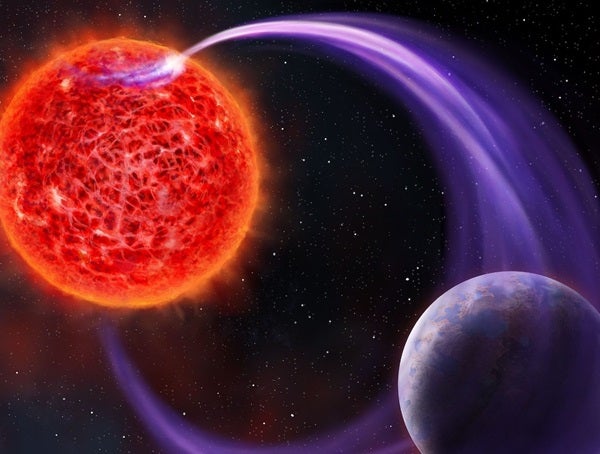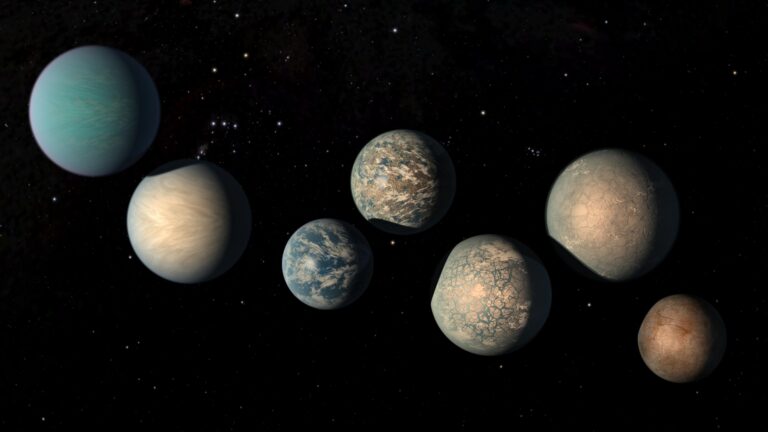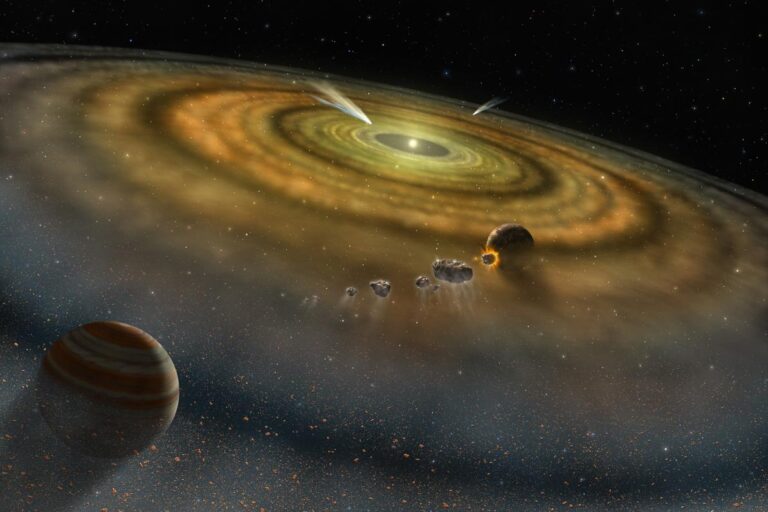Astronomers have discovered a terrestrial-mass exoplanet orbiting a tiny red dwarf star less than 30 light-years from Earth. And although finding yet another exoplanet is nothing new, what’s unique is exactly how the researchers discovered the exotic world: They hunted for radio waves emitted by glowing aurorae.
The new observations — made with the Low Frequency Array radio telescope (LOFAR) in the Netherlands — indicate a planet less than about five times the mass of the Earth is in a quick orbit around a petite red dwarf named GJ 1151. And thanks to the stars’ magnetic field interacting with the close-in planet’s atmosphere, the researchers were able to detect the telltale radio signatures of aurorae.
The research — both concerning the radio emissions, as well as an exploration of alternative explanations — was recently published in Nature Astronomy and Astrophysical Journal Letters.

Would you like to learn more about exoplanets and other solar systems? Check out our free downloadable eBook: Our search for extrasolar planets.
Revealing aurorae
Aurorae are caused by magnetic fields, but the processes that produce them can take different forms. The well-known aurora borealis (the northern lights) and aurora australis (the southern lights) is caused when Earth’s magnetic field funnels charged particles from the solar wind to Earth’s poles, where they strike atoms in our atmosphere. On Jupiter, however, brilliant aurorae arise in response to charged particles from its moon Io, accelerated by the gas giant’s powerful magnetic field, colliding with its upper atmosphere.
In the case of the newfound world around GJ 1151, the researchers paint a picture of a planet magnetically connected to its star, producing aurorae as the two interact. According to Joseph Callingham, a Veni Fellow at Leiden Observatory at Leiden University, these exoplanetary aurorae are expected to look brighter and more intense than anything seen on Earth, sporting purple and yellow hues that only appear in Earth’s strongest light shows.
This sort of magnetic activity produces radio emissions, which radio astronomers have long hoped to use to find and study exoplanets. In 2018, for instance, astronomers discovered the impressive auroral activity of a rogue exoplanet called SIMP J01365663+0933473 (or simply SIMP). This marked the first detection of aurorae on a planet-sized object outside our own solar system. If confirmed, the recent observations of GJ 1151 will go on to serve as the first detection of star-exoplanet interaction at radio frequencies.
“All previous methods of detecting exoplanets around main-sequence stars use optical telescopes,” says Benjamin Pope, a NASA Sagan Fellow at New York University who was involved with the research. “By opening the radio window, we don’t necessarily know what we will find!”
And because most red dwarf stars — which are thought to account for roughly 75 percent of the stars in the universe — have exceptionally strong magnetic fields, this new method of detecting exoplanets based on their auroral activity could be particularly revealing.
Narrowing in on a planet
The team uncovered the radio emissions from this planet by trusting the idea — inspired by results from the Kepler Space Telescope — that nearly every star has orbiting planets. When Callingham was working on the LOFAR Two-meter Sky Survey (LoTSS), which aims to survey the whole northern sky, he and his team got the idea of scouring the data for signatures that are suggestive of aurorae caused by star-planet interactions.
Once they found the planet around GJ 1151, though, they had to make sure it really was an exoplanet. Specifically, that meant ruling out other explanations for the radio emission, such as the possibility that it’s caused by GJ 1151 interacting with a distant giant planet or a binary star. But based on their follow-up investigations, the team believes they’ve found an Earth-sized planet too small to detect with optical instruments.
Optimistically skeptical
Other radio astronomers, however, responded to the findings with both caution and excitement.
Evgenya Shkolnik, a professor of astrophysics at Arizona State University who is an expert on star-planet interactions, says, “It’s only now that we have these sensitive detectors that people are staring at stars and trying to figure out if the star itself can do this without the presence of a planet.” To truly confirm that this is an exoplanet and this method of detection works, she says, the team will have to prove that the radio signal matches the suspected planet’s orbital period. But she adds that the team has statistics on their side and that the planet probably exists.
Detecting this radio emission is a big result in its own right, says Melodie Kao, a Hubble Postdoctoral Fellow at Arizona State University who led the study on SIMP. If these results are confirmed, it could suggest that the magnetic fields of terrestrial planets can be much stronger than previously predicted, which opens up exciting possibilities for understanding these processes and interactions.
“If this proves to be correct and real, this team will find a lot more of these objects, and it could be a whole new way to find exoplanets orbiting [red] dwarfs,” says Gregg Hallinan, an astronomer at Caltech who helped detect SIMP’s magnetic field. Hallinan adds that “the next big step will be detecting direct radio emission from exoplanets themselves.” Doing that would open up the possibility of studying the physics and atmospheres of these exoplanets.
Looking ahead to radio detection
In addition to working to confirm signs of the orbital period of GJ 1151’s planet, the team is seeking evidence of similar emissions from other stars. They’re also looking forward to what this method could teach them about red dwarfs and their exoplanets.
“Radio aurorae have the potential to be a new mode of exoplanet discoveries, as well as a powerful probe of their interiors. If we want to make the most of the new discoveries that radio exo-aurorae can open up, we need our communities and businesses to help us ensure that our skies remain clear for radio observations,” says Kao.










